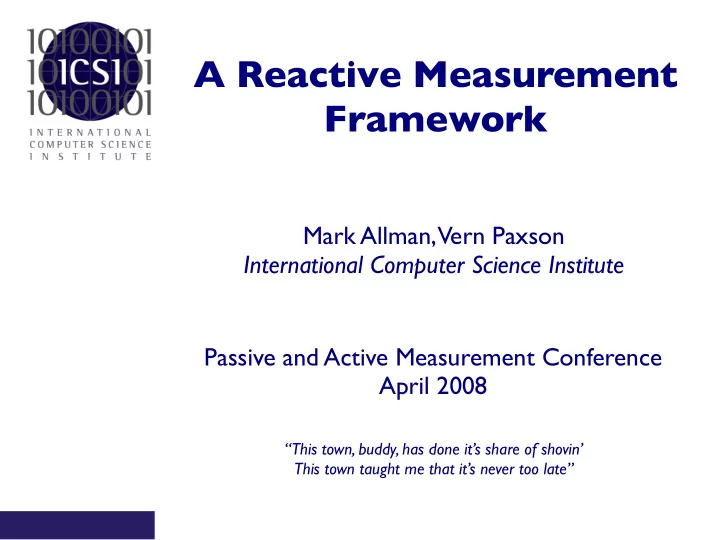

A Reactive Measurement Framework Mark Allman, Vern Paxson International Computer Science Institute Passive and Active Measurement Conference April 2008 “This town, buddy, has done it’s share of shovin’ This town taught me that it’s never too late”
Overview • Difficult to understand networks due to the vast array of integrated components • some known, some not (whee!) • Usual approach is to measure and wonder Allman 2
Overview (cont.) • E.g., we know nothing about the routing state by looking at a packet trace • E.g., we know nothing about the connectivity when observing a DNS lookup failure • E.g., we don’t understand if a web fetch failed because of DDoS, duplex mis-match, proxy failure, ...... • E.g., we don’t understand why a SYN didn’t elicit a SYN+ACK Allman 3
Reactive Measurement • Old way: measurement as an event • New way: measurement as a process Allman 4
REM (cont.) • REM calls for disparate measurement tools to be orchestrated in a way that leads to better fundamental understanding • Simple but powerful notion Allman 5
REM (cont.) Success curl Done Success Failure traceroute Failure Allman 6
Related Work • Used operationally • E.g., SNMP traps • E.g., IDS • Ad-hoc use in research Allman 7
Application #1 • Fundamental new approach to answering questions • E.g., how long do DNS failures persist? Allman 8
Application #2 • Targeted measurements • E.g., packet capture only at key times • Eases measurement logistics • not a small contribution Allman 9
Application #3 • Network anomalies can be better understood • now often a footnote in a paper Allman 10
A REM Architecture • Goal: to build a simple glue to allow for ... • quickly bonding disparate measurements • dealing with general resource issues (e.g., runaway measurements) • dealing with collecting data intelligently • Hope: a reasonable toolkit will foster REM studies Allman 11
REM Architecture (cont.) config passive meas remd active meas reactive meas Allman 12
Sample Experiment • What is the cause of web fetch failures? Allman 13
Experiment (cont.) DNS error || curl killed IP resolved && fetch failed clink curl IP resolved && fetch failed HTTP port unreachable HTTP port open tcptraceroute curl fetch failed Allman 14
Experiment (cont.) • 408K fetches, Dec/07--Feb/08 • 5.5K failures on initial curl (1.4%) • 23% were fixed within the measurement period (~20 min) • 77% persisted throughout the measurement period Allman 15
Experiment (cont.) • Initial failures that ultimately succeed • 49%: connected, but failed to get data • 18%: DNS error • 15%: successful HTTP transaction, but no actual content • 10%: failure to connect to server • 5%: partial fetch completed • etc. Allman 16
Experiment (cont.) • Persistent failures • 50%: DNS errors • 30%: connected, but failed to get data • 11%: failure to connect to server • 6%: successful HTTP transaction, but no actual content • etc. Allman 17
Problem: State Machines • We have found state machines to be somewhat restrictive • E.g., simple cases where we want to assess the network in two ways and then take action based on both results • E.g., engaing with external measurement infrastructure such as DipZoom • Lousy workarounds: • Run serially • Push complexity to wrapper scripts Allman 18
Contributions • Looking to examine and espouse the general power of the REM approach • Building a toolkit to make utilizing REM techniques straightforward • Feedback on our initial thinking. Allman 19
“If there’s something you want, If there’s something you need, .....” Mark Allman mallman@icir.org http://www.icir.org/mallman/
Recommend
More recommend